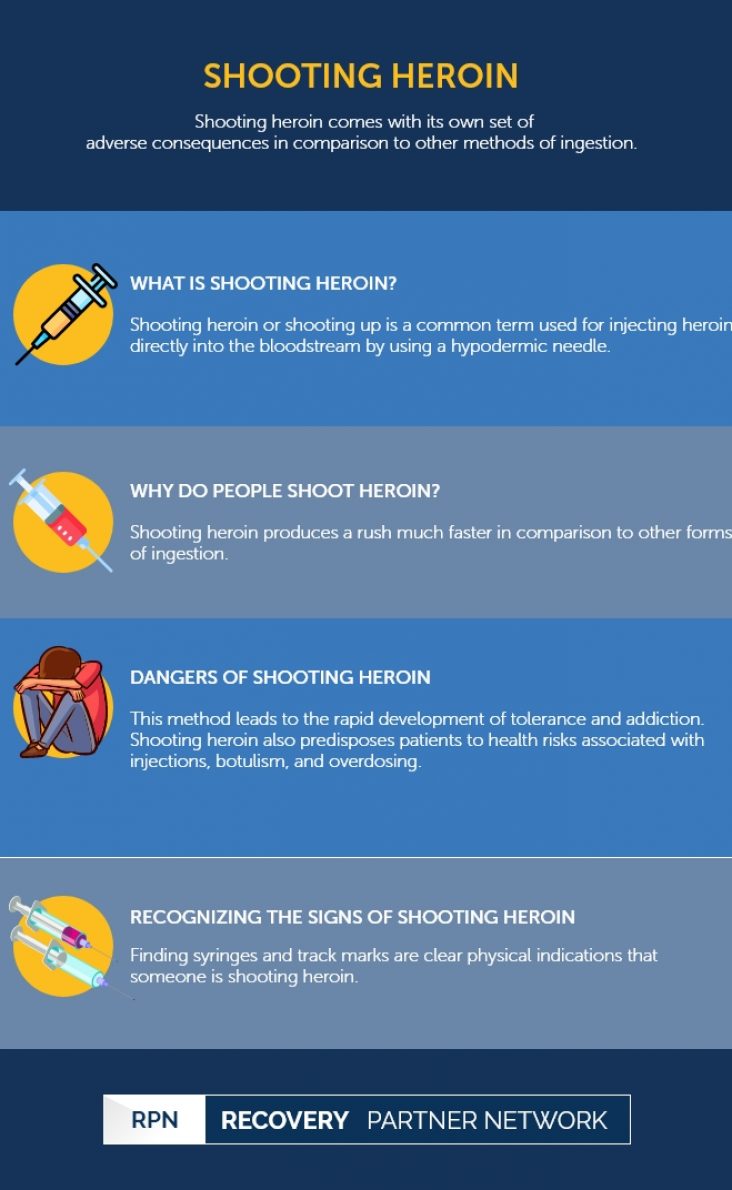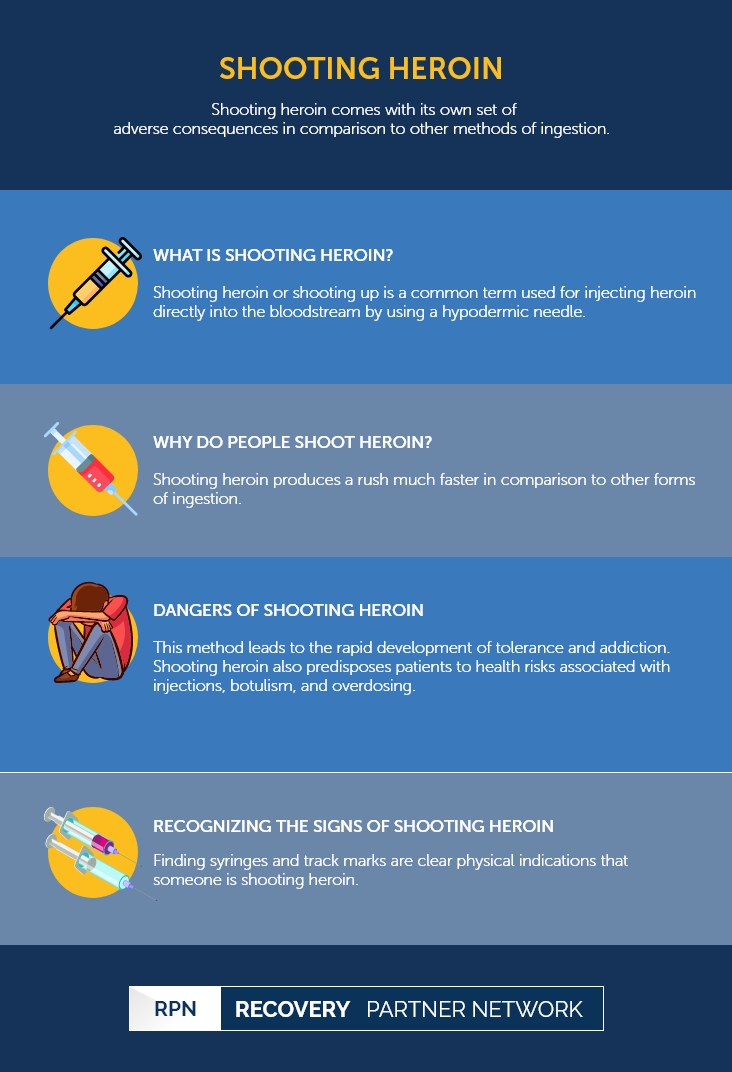Shooting heroin comes with its own set of adverse consequences in comparison to other methods of ingestion.
Shooting Heroin
Illicit drugs
- Ayahuasca addiction – Abuse
- Baclofen addiction
- Black tar heroin addiction
- Cannabis addiction
- Cocaine dependence
- Crack cocaine addiction
- DMT addiction abuse treatment
- Does Marijuana Kill Brain Cells?
- Ecstasy addiction
- Gabapentin addiction
- gamma-Hydroxybutyric acid addiction
- Hallucinogen
- Heroin addiction
- Illicit drug addiction
- Inhalant addiction
- Cocaine
- Ketamine addiction
- Lysergic acid diethylamide addiction
- Mescaline addiction
- Methamphetamine addiction
- Meth Labs: Cooking up Addiction
- Meth Mouth
- Microdosing
- Phencyclidine addiction
- Psilocybin mushroom addiction
- Sage of the diviners – Addiction
- Shooting Heroin
- Shooting Methamphetamine
- Smoking Cannabis
- Speedball
- Synthetic cannabinoids
Shooting Heroin | Table of Contents
What is Shooting Heroin?
Shooting heroin or shooting up is a common term used for injecting heroin directly into the bloodstream by using a hypodermic needle. This form of heroin consumption results in the most potent drug effects due to its ability to directly interact with the bloodstream and pass immediately to the brain.
Heroin is usually sold in two forms, such as white powder and black tar. The white powder form can be consumed through snorting, smoking, or injecting. However, the black tar heroin is generally consumed by diluting the substance and injecting it. Regardless of the method of consumption, users may experience a feeling of intense euphoria as the chemical compound found in heroin converts to morphine in the brain once consumed. First-time users of heroin generally do not choose this intrusive method of consumption. This is a method that’s widely practiced among long-term drug abusers, is the riskiest form of consumption.
FAQ
Some of the physical signs of shooting heroin may include the appearance of injection sites throughout the body, collapsed veins, skin popping, infected sites on the skin, and soot tattoos.
Injecting heroin can lead to serious health consequences and permanent damage. Some of the dangers of injecting heroin may include the risk of developing infections, heart problems, contracting or transmitting HIV and other diseases, and increasing the chances of a fatal overdose.
Why do People Shoot Heroin?
Shooting heroin produces a rush much faster in comparison to other forms of ingestion. Due to the excessive potency of this drug, dependencies, tolerance, and addictions occur much rapidly. Although the effects are activated much faster through injecting, the effects are relatively short-lived. Individuals who inject heroin experience withdrawals much faster and, as a result, become more desperate to attain the drug and alleviate the symptoms as soon as possible. Subsequently, the quickest way to alleviate withdrawal is through injecting the drug and thus creating a vicious cycle of abuse.
Dangers of Shooting Heroin
Other than the rapid development of tolerance and addiction, shooting heroin predisposes patients to additional health risks associated with the use of injections. Drug users usually share needles, which increases their chances of contracting blood-borne viruses, many of which are highly dangerous. Individuals under the influence of heroin often engage in risky and violent behavior, which increases the chance of injury and infectious disease.
The improper use of injections can cause a variety of health issues ranging from physical scarring to life-threatening infections. If the injection is too shallow, heroin can collect in areas below the skin, causing infections and abscesses. On the other hand, if the needle pushes too far, it can pierce the intended vein and place heroin on the other side, resulting in a similar issue. However, the most apparent effect of shooting heroin is the loss of functioning veins. Repeated use of injections can cause collapsed and decaying veins. If a viable vein is no longer accessible, users then inject the drug into the skin or muscle tissue. Abscesses and infections caused by repeatedly shooting heroin can lead to complications that would require skin grafting or complete limb amputations if left untreated.
Overuse and sharing of syringes can lead to some of the most severe long-term health risks. Using the same needle repeatedly can cause the tip to blunt over time. As the tip blunts, the entrance into the skin and veins becomes messier, thus increasing the chances of infection and improper healing.
Syringes shared by multiple people pose a severe risk of blood-borne illnesses. Diseases such as HIV and hepatitis pose a grave danger to consumers of injection drugs (IDUs). Damages caused by the drug and the injection used to consume the drug can both potentially lead to adverse consequences not just to the user but to those around them as well.
Shooting Heroin and Botulism
Individuals who inject drugs have a higher risk of contracting wound botulism, a life-threatening illness plagued by many heroin users. The risk of contracting this illness is highly increased if an individual injects black tar heroin under the skin or into the muscle tissue. This illness is caused by a germ known as Clostridium botulinum that enters open wounds and creates a toxin that attacks your nerves. This can cause the user to suffer from severe respiratory decrease, muscle weakness, and even death. Although there is no cure for this illness, it could be managed by a medication known as an antitoxin.
Symptoms of botulism generally appear several days or weeks after contamination. Some of the symptoms of this illness resemble an opioid overdose. Although botulism is not contagious, it can be contracted through the use of contaminated heroin or the injection used to consume it.
Symptoms of botulism may include:
- Double vision
- Drooping eyelids
- Difficulty in swallowing
- Blurred vision
- Dry mouth
- Muscle weakness
- Slurred speech
As the disease worsens over time, users may experience difficulty in breathing or even paralysis. It has been estimated that 20 individuals every year are diagnosed with botulism in the US. However, the numbers are most likely higher than what is recorded as heroin users generally do not seek treatment for the illness as they are unaware of it or not bothered by it.
Overdose
All users are at risk of overdosing while using heroin, but injecting is correlated with significantly higher chances. When injecting heroin, the patient bypasses some of the filtering and dilution processes of the body. The digestive system, the kidneys, and the liver help metabolize and dilute the substances when ingested. However, when injecting the drug, it passes straight through the bloodstream and significantly increasing their chances of an overdose.
Recognizing the Signs of Shooting Heroin
Behaving evasively, unexpectedly needing to borrow money, and periods of lethargy suggest that someone is using heroin.
Track marks are clear physical indications that someone is shooting heroin. However, a person can also experience rapid weight loss, red eyes, and constricted pupils.
Finding syringes is the most apparent indication of use, but spoons and lighters are also part of the shooting process.
Recovery Partner Network
We aim to educate and empower. If you feel our library of resources does not cover your specific need, reach out to us, and we would be happy to help.
STATISTICS
© Copyright 2024


